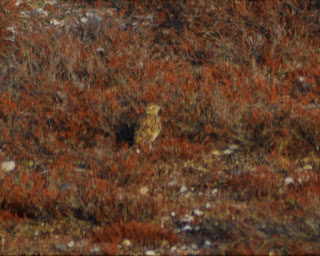I then got to the beach were I had my first ever Graylings which is a small butterfly that has very good camouflage when its siting on the ground. As I was walking along I had my eyes to the sea were a flock of about twenty Wigeon went past then two Sandwich Terns flew through followed by a singular Oystercatcher there was also a lovely male Stonechat in the bushes
Stonechat.
We then headed into East Hide were there was lots of Avocets, a few Snipe, a Common Sandpiper, a Hobby over the back, some Black Tailed Godwit and three Greenshanks that flew in calling. There was a few of the feral Barnacle Geese sitting on the scrape.
We then headed for the Sluice however there wasn't anything in the bushes but there was lots of House Martins and Swallow there was also four Kestrels flying around each other.
We then walked into the South Hide were I was put on to the Semipalmated Sandpiper within a minute. This was my 272th lifer I then meet David Walsh and his friend in the hide. Here he showed me the differences between Common and Spotted Redshank as there was lots of them around the scrape there was also a large group of Common Terns and Little Gulls with some juveniles in it.
Semipalmated Sandpiper.
We then walked to Wildlife lookout where we had a Brown Hawker, a Migrant Hawker, a Marsh Harrier and a surprise Greater Silver Diving Beetle Larva which I almost stepped on. I wasn't sure what it was at first then David started telling us about it saying it is poisonous and squeaks if it is touched.
Greater Silver Diving Beetle Larva
Migrant Hawker
We then walked into the Wildlife Lookout where there was some Green sandpipers, a Greenshank, Juvenile Great Black-backed Gulls, and a very odd Ruff that had a white head and brown body. this was a nice looking bird. Then a Great White Egret dropped in behind the hide however we were looking into the sun but it was still nice as it was a lot closer than the last two.
We left the hide and started walking to the North Wall to look for Bee Wolfs on the way we had four+ Willow Emerald Damselflies which David put in his scope that made them look incredible. We then walked to the North Wall were I saw my first Bee Wolfs. David told us that Bee Wolfs catch five Bees and drag them down there hole then once there is five they will lay one egg and they cover the hole over and leave the eggs to hatch and feed on the bees.
We then headed to Island Mere where we had another Great White Egret and some Bearded Tits.
Great White Egret.
We then headed to Weselton Heath where we saw more Graylings six Stone Curlew four Woodlark and a Dartford Warbler.
Woodlark
GraylingDartford Warbler
In total I saw 67 species of bird on a great day out Minsmere is definitely one of my favourite reserves.




















